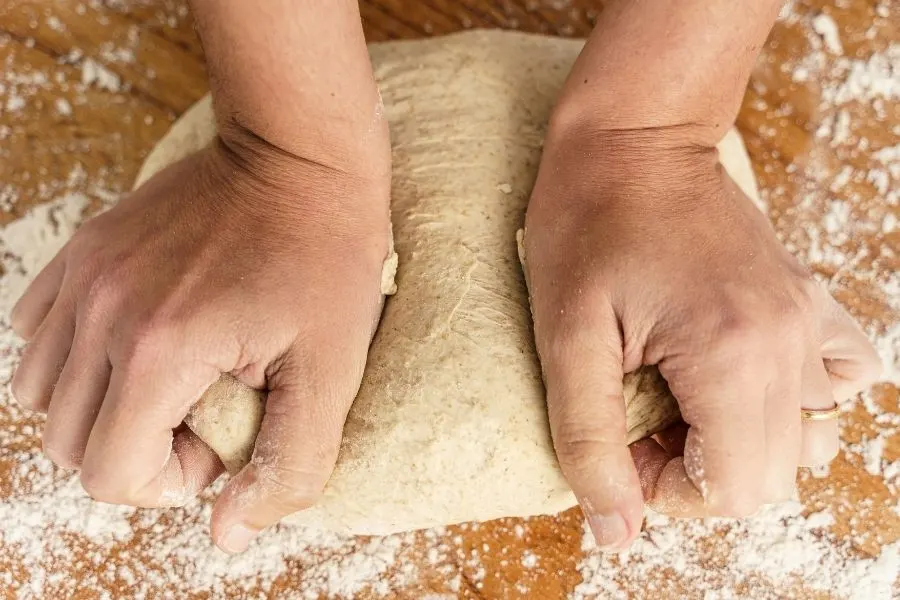Bread is an essential part of many people’s lives, and knowing how to make some bread can prove a very useful skill. Even fi you’re not making your own bread, knowing the ins and outs of bread-making can help you pick out the perfect bread for your tastes. And a key point with bread is its texture and structure, which you may have heard is directly related to how much the bread is kneaded.
But why is bread kneaded in the first place ? How does kneading help bread develop its structure ? What happens when you don’t knead it enough ? Can you make bread without kneading it at all ? Let’s take a look.

Why is bread dough kneaded ?
Bread dough is kneaded to form its gluten structure, so that the tiny CO2 bubbles may be trapped in the dough as it rises. This creates the texture and rise we all know and love in bread. A bread that isn’t kneaded enough will fall flat or deflate and turn out very dense.
A bread that has been kneaded too much can become too chewy and dense, but will still rise more than the under-kneaded one.
Kneading bread develops the gluten structure
Gluten has a key role in regular white bread, and that is to develop a structure that is strong enough to keep the tiny gas bubbles from escaping through the dough, and also elastic enough that the dough end up rising. Getting gluten to this point takes a while.
When you first start mixing the dough, the gluten is not formed. It’s still the shape of two different proteins: glutenin and gliadin. The more you knead the dough the more those two proteins expand and get closer, eventually forming long strands of gluten. And the more gluten strands knotted together, the better the structure in the bread. A well-mixed bread will have all those nice bubbles.
Read also: Puff Pastry VS Croissant Dough
You may be wondering what makes those bubbles. Those are tiny CO2 pockets that are trapped by the gluten structure. And the bubbles are made by the yeast, as it eats through the small amount of sugar the recipe calls for. No sugar in a year recipe will mean no rise. If you’re making bread without yeast, you’re not likely to use sugar as there is no need for it, and you’re probably using baking soda.
Kneading spreads all ingredients evenly
Another reason to knead bread is that you spread all the ingredient evenly. This leads to no salty or sweet pockets, and it means all the flour is evenly distributed.
If you’re making a bread with fillings, like olives or onions or garlic or herbs, you definitely need to knead the dough properly to make sure everything is well distributed.

What happens if you don’t knead bread ?
When you don’t knead bread enough you don’t develop the gluten structure. This means your bread can end up dense and heavy, with just a few big bubbles here and there. It will bake unevenly and end up crumbly, very difficult to eat with.
How do you know when to stop kneading bread ?
Poke the bread, see if it rises back quickly. If your dough is springy and resumes its shape in a second or two, you’ve kneaded it enough and it will rise beautifully. If it the poked hole comes back very slowly keep kneading, and repeat the test in another 2 minutes.
Developing enough gluten can take anywhere from 10 to 15 minutes, depending on how fast you knead and how deep you’re kneading. Simply turning the dough over and over again is not enough, if you’re doing this by hand. You need to fold, stretch, punch, roll, and generally work the dough to get enough gluten.
If you have a stand mixer you can get a hook attachment that will knead the dough for you, but you still have to let it run 10-15 minutes.
Is there no-knead bread ?
Yes, you can make no-knead bread and it’s very simple to make, especially compared to the rest of the bread recipes. You simply need to mix the ingredients as usual, but when it comes times to knead the bread, you pack the dough in the fridge for at least 12 hours.
The dough will slowly rise, which is key here, because you don’t want to lose the yeast. However as the dough sits in the fridge it slowly develops those gluten bonds and you will get a good bread dough.
This is kind of why you need to actively knead the dough. If you leave it by itself, it will happen anyway in a few hours, but if you help it along it’s doe in 10-15 minutes.
You may be wondering if you can just keep the dough on the counter for fewer hours and get the same result. The answer is no, because your yeast will move too fast by then, and you’ll lose all the rise it can give you. The fridge is the way to go.
And that’s pretty much it. Now you can even make your own bread as a project, or just better understand that piece of toast.

